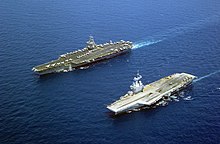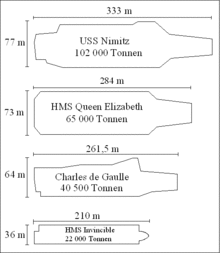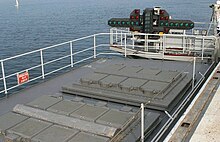Charles de Gaulle (R 91)
|
||||||||||||||
|
||||||||||||||
|
||||||||||||||
|
||||||||||||||
The Charles de Gaulle is a nuclear powered aircraft carrier and the flagship of the French Navy . It replaces the aircraft carriers Foch and Clemenceau and is named after the French general and statesman Charles de Gaulle .
The Charles de Gaulle is the largest ship in the French Navy.
General
The Charles de Gaulle ( NATO - identification R 91) is compared to that of the United States is relatively small used aircraft carriers. It is 261.5 m long, 64.36 m wide and 75 m high. With a displacement of 40,600 tons, it has a crew of around 1950 people and, as a troop transport, can hold an additional 800 soldiers. The area of the flight deck is approx. 12,000 m², the hangars have an area of approx. 4,600 m².
The Charles de Gaulle is - as the only aircraft carrier outside the US Navy - nuclear- powered and can travel 1000 km a day without restrictions. The carrier can theoretically operate autonomously for up to 45 days.
It is usually equipped with 40 aircraft of the types:
- Fighter aircraft : Dassault Rafale Marine
- Fighter-bomber : modernized Dassault Super Étendard by July 2016
- Grumman E-2 Hawkeye air surveillance
- Helicopters of the type Eurocopter AS 565 Panther rescue and anti-submarine defense missions
A maximum of 100 flights per day can be completed over a period of seven days. The minimum time interval between two take-offs or landings is 30 seconds.
history
context
The Charles de Gaulle replaced the conventionally powered aircraft carriers Clemenceau and Foch , which entered service in 1961 and 1963, respectively. A replacement was discussed for the first time in the 1970s, as problems repeatedly occurred on both aircraft carriers.
construction
Construction of the Charles de Gaulle began on November 25, 1987. The shell was assembled in April 1989 in the DCN shipyard in Brest . Construction ended in May 1994; At 42,500 tons, the Charles de Gaulle was the largest warship in Western Europe since the British HMS Ark Royal entered service in 1950.
By using the shipyard in Brest, the maximum length of the ship was limited, which forced unusual solutions. The flight deck was designed to be very wide in order to obtain the necessary freedom of movement on deck. This made it necessary to use active stabilization (SATRAP), which is additionally supported by twelve movable weights of 22 t each (COGITE system).
Two pressurized water reactors of the type K-15, as used in French submarines, are used for propulsion. They also provide the steam to operate the two catapults. These catapults correspond to the American model C13, but are only 75 m long (compared to 90 m on the US girders). The landing system, which consists of three safety cables, also corresponds to that of the US Navy.
The bearer was christened Richelieu in 1996 , but renamed Charles de Gaulle by then President Jacques Chirac the following year .
espionage
In 1993, according to media reports, a group of MI6 officers who had posed as engineers were exposed. It is believed that they wanted to spy on the nuclear reactor.
Tests and technical problems
The first tests in January 1999 showed that it was necessary to extend the runway in order to allow the E-2C Hawkeye to land . Such work had already been necessary on the Foch and the Clemenceau to enable the F-8 Crusader to land . This fact was not welcomed by the French public, as by that time the construction had already become twice as expensive as originally estimated. The cost of the extension of 5 million francs, however, corresponds to just 0.025% of the total budget of Charles de Gaulle .
On February 28, 2000, a test of the nuclear reactors triggered a fire in insulation materials, which resulted in a lot of smoke.
In the night from 9 to 10 November 2000, whereas the carrier toward Norfolk ( Virginia ) on the way, broke the port propeller; the ship had to return to Toulon to have the propeller replaced. The subsequent investigation showed that the replacement propellers had the same structural defects. The supplier was to blame for this. Until a final solution was found, the outdated propellers of the Clemenceau and Foch were used provisionally , which reduced the top speed from 27 to 25 knots, but did not restrict flight operations.
On March 5, 2001, the carrier set sail again with the two older propellers and reached a top speed of 25.2 knots. New propellers were installed in 2009, as the optimal carrier speed for the operation of the new version of the Rafale fighter aircraft is 27 knots.
On May 18, 2001, the Charles de Gaulle was officially armed. At this point it already had a reputation for being a billionaire grave.
From July to October 2001, the Charles de Gaulle had to go back to the dock because one of the propellers generated a volume of around 100 dB , which made the rear part of the ship uninhabitable.
Active service
On September 16, 2001, the press reported abnormal radioactive levels on board the carrier. This was probably due to a defective insulation line.
While the United States organized the response to the September 11, 2001 attacks in the form of Operation Enduring Freedom , the French press complained of a lack of military strength of its own. At the same time, the Defense Commission reported that the quality of maintenance on the fleet was poor. In this context, the Charles de Gaulle , which was again under repair, was again the target of criticism. Former President Valéry Giscard d'Estaing spoke of a “demi porte-avions” (“half an aircraft carrier”). Then the Charles de Gaulle took part with several other French warships in Operation " Heracles " and supported the coalition forces in Afghanistan with their Super Étendard aircraft . This mission lasted a total of seven months until the Charles de Gaulle returned to Toulon on July 10, 2002.
In the following years, the carrier performed regular missions, mainly in the Indian Ocean .
On July 31, 2007, the Charles de Gaulle was relocated to a dry dock in Toulon for a longer overhaul break. The main points were the renewal of the electronic infrastructure, the adaptation of the ship's technology to the F3 version of the Rafale and the replacement of the reactor fuel rods. The replacement of the replacement screws was also part of the program, which paralyzed the carrier by March 2009. However, after problems with vibrations and heavy wear in the drive system, the return to service was delayed until December 2009.
Link 16
On October 11, 2001, four AWACS aircraft, the frigate Cassard and the Charles de Gaulle successfully participated in the test of the Link 16 , a new specially secured network. The network enables real-time monitoring of air traffic between southern England and the Mediterranean . The data was the air defense - frigate Jean Bart via link 11 transmitted in real time.
Gas incident
On November 8, 2001, a seaman doing maintenance fainted from a gas leak. Another sailor tried to save him and also passed out. Both were rescued by medical teams and taken to a hospital in Toulon. Both sailors survived the incident, but the Charles de Gaulle again came under massive public criticism.
Operation Heracles in Afghanistan

On November 21, 2001, France decided to send the Charles de Gaulle to the Indian Ocean and support the United Nations' Operation Heracles in Afghanistan.
The Task Force 473 , with 2,900 men under the command of Rear Admiral François Cluzel began on 1 December. The task force consisted of the aircraft carrier Charles de Gaulle , the frigates La Motte-Picquet , Jean de Vienne and Jean Bart , the nuclear attack submarine Rubis , the supply ship Meuse and the Aviso Commandant Ducuing .
The French Air Force within Task Force 473 consisted of 16 Super Étendards, an E-2C Hawkeye, two Rafale and several helicopters.
On December 17, 2001, Task Force 473 was integrated into the international armed forces alongside the US aircraft carriers USS Theodore Roosevelt and USS John C. Stennis and the Italian Giuseppe Garibaldi . The armed forces consisted of over 100 French, American, Canadian, British, German, Italian, Dutch, Australian, Spanish and Japanese ships under the international allied command in Bahrain .
The Super Étendards began their first Afghanistan mission on December 19, 2001 with the reconnaissance and bombing of targets 3,000 km away. A total of 140 missions were flown, an average of twelve per day. The aircraft were able to repel attacks from a total of five FIM 92 Stinger missiles.
On February 18, 2002, the Helios observation satellite registered abnormal activity at Gardez . After special forces of the US Army had confirmed this on site, two Super Étendards scouts were launched by Charles de Gaulle the next day . British and American forces entered the valley on February 20, and Operation Anaconda began on March 2 .
In March, Super Étendards and six land-based Mirage 2000 attacked Al Qaeda targets . Some targets proposed by the Americans were rejected out of fear of civilian casualties. Nevertheless, on March 11, 2002, US President George W. Bush praised the mission with the words: "Our good ally France, who made a quarter of its fleet available for Operation Enduring Freedom" . At that time the clout had been expanded to 16 Super Étendards, six Mirage 2000 D, five Rafale and two air surveillance aircraft Grumman E-2 Hawkeye. Two land-based Boeing KC-135 tanker aircraft significantly extended the aircraft's service life over Afghanistan. From February, the Charles de Gaulle and the John C. Stennis exchanged planes with each other in order to deepen the bond between the Allies.
On May 2nd, the Charles de Gaulle reached Singapore to make a stopover and continue on to Oman on May 18th. At the same time, tensions over Iraq began. Vice-Admiral François Cluzel told the press: “France is against any action against Iraq. If something is done, France will most likely not be part of the coalition ” .
Rescue mission
On October 9, 2009, CrossMed (Regional Operational Center for Monitoring and Rescue in Mediterranean Sea) received an emergency call from Babolin , a leaky 8-meter boat. The Charles de Gaulle , which was on a maneuver, sent a helicopter into the sector that was able to save the three men of the crew despite heavy seas, wind speeds of 35 knots and poor visibility.
Visit to the port of Cuxhaven
On April 9, 2010, the Charles de Gaulle , accompanied by the two frigates Cassard and Forbin , visited a German port for the first time. The aircraft carrier was at Steubenhöft in Cuxhaven from April 9th to 11th, 2010 and then took part in the NATO maneuver Brilliant Mariner in the North Sea.
Counter-terrorism mission
After the terrorist attacks in Paris on January 7, 2015 against the editorial staff of Charlie Hebdo , President François Hollande instructed the aircraft carrier Charles de Gaulle to support the operation against IS from the Indian Ocean . In February and March, the carrier served as the base for the French Air Force attacks against IS positions in Syria . After completion of maintenance work, the Charles de Gaulle was supposed to leave the port of Toulon on November 18, 2015 , the Persian Gulf was the area of operation and the arrival in the target area was scheduled for mid-December. After another series of attacks in Paris on November 13, 2015 , Hollande set the eastern Mediterranean as the new target area. Russian President Putin instructed the cruiser Moskwa , which operates there, to cooperate with the French ship. Immediately beforehand, the head of the Russian domestic intelligence service, Alexander Bortnikov , announced that the crash of a Russian passenger plane on October 31, 2015 was also believed to be a terrorist attack. From November 23, 2015, Charles de Gaulle's fighter jets were used to attack IS positions in Syria.
maintenance
The Charles de Gaulle has been in the port of Toulon since February 2017 to be overhauled. The maintenance work, which was planned for around 18 months, included replacing the fuel elements, converting the deck for the exclusive use of the Rafale (the Super Étendards were decommissioned) and sensors and reconnaissance systems. In March 2019 she returned to regular service.
COVID-19 infections
In mid-April 2020 it was announced that 1,041 crew members of the aircraft carrier and its escort ships had tested positive for COVID-19 . All 2300 crew members were tested, the soldiers in Toulon and the surrounding area were isolated for 14 days. The ship last had a stopover from March 13 to 16 in Brest.
Trivia
- The Charles de Gaulle makes an appearance in Gemo 13 , a French action and espionage film.
- In the book Operation Elite by Matthew Reilly has Charles de Gaulle also made an appearance.
See also
Web links
- Information about the aircraft carrier on the Navy website (French)
- Information on the aircraft carrier (French / English) on the netmarine.net page
- The site interactif sur la Marine nationale et le porte-avions nucléaire Charles de Gaulle Charles de Gaulle
- Charles de Gaulle - MaritimeQuest Gallery
Individual evidence
- ^ Cuxhaven welcomes aircraft carrier "Charles de Gaulle" In: Weser-Kurier .
- ^ Jane C. Timm: France steps up involvement in fight against ISIS. In: msnbc.com , January 14, 2015, accessed November 16, 2015.
- ↑ French aircraft carrier set off for the Gulf next week ( memento of the original from November 25, 2015 in the Internet Archive ) Info: The archive link was automatically inserted and not yet checked. Please check the original and archive link according to the instructions and then remove this notice. Die Zeit, November 13, 2015, accessed on November 17, 2015
- ^ Thomas Pany: France wants European military support : Telepolis, November 17, 2015, accessed on the same day
- ↑ Thomas Pany: Airbus crash: Moscow confirms assassination thesis : Telepolis, November 17, 2015, accessed on the same day
- ^ Jean-Christophe Féraud: Révision générale pour le "Charles-de-Gaulle". Liberation, March 1, 2017, accessed March 23, 2017 (French).
- ↑ 1041 French infected: Corona is rampant on aircraft carriers. In: n-tv.de. April 17, 2020, accessed April 18, 2020 .





